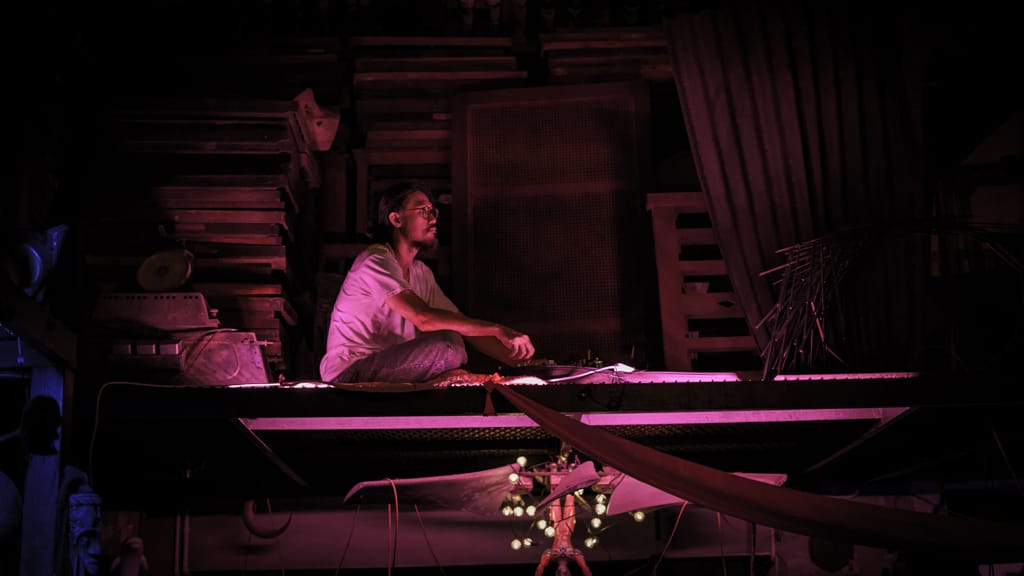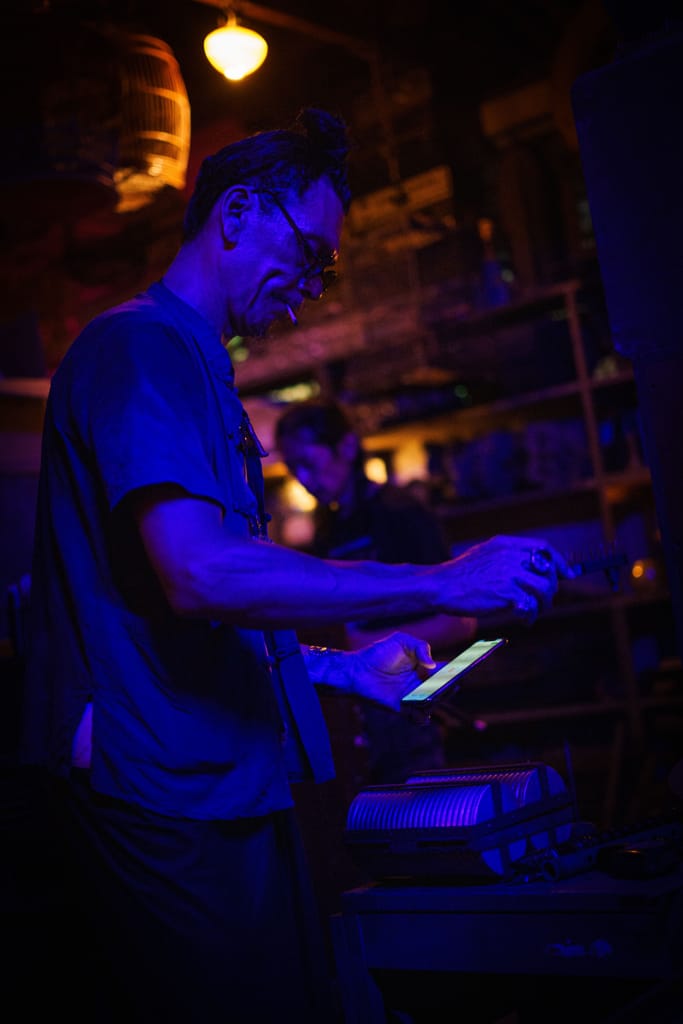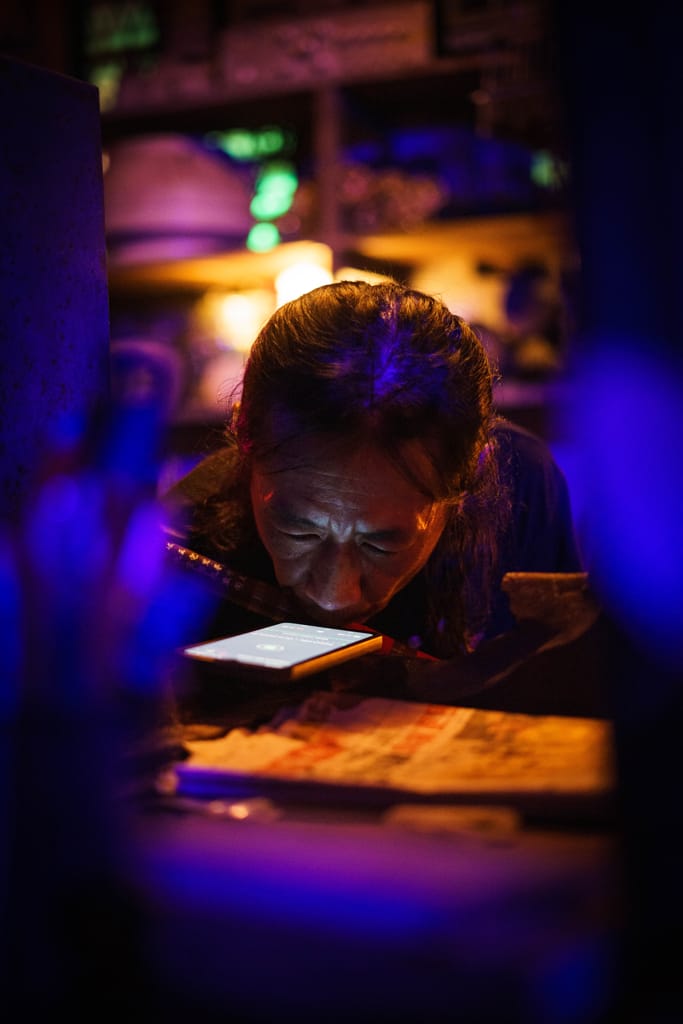Sounds and Silence: Experimental Music Permeates Penang Spaces
By Liani MK
May 2024 FOR ART'S SAKE
Photos by Shankar Laxminarayan and courtesy of Kamal Sabran.
IN AN ECLECTIC studio tucked in Ipoh, the figure of a bearded man is seen toggling keypads and buttons on his synthesiser (or synth, in short) in a room warmly lit by a table lamp. Under framed pictures of Sufi scholars, a curious cat tiptoes across dusty books and cassettes, a pothos plant curls in a corner. Prominently displayed are a vintage oscilloscope and Ace Tone analogue drum machine.
It is obvious that Kamal Sabran is not an ordinary senior lecturer at Penang’s Universiti Sains Malaysia. The musician-researcher, who holds a PhD in Art and Design (New Media), is best known as a music tinkerer. Among his 2.47K YouTube subscribers and 237K Instagram followers, he has been described as a wizard of sorts; his gadgets spit out mind-bending soundwaves with intermittent silence—a space he likes to call “soundscape”.

If Kamal is a synth wizard, he has clearly fashioned for himself a spiritual terrain of meditative sounds, which he also says is a remedial source for managing symptoms of dementia and Alzheimer’s. Other than researching sound’s healing potential, Kamal experiments a lot with cultural elements as well—even integrating traditional sounds of the Arab-Malay lute known as gambus.
Experimental music—a catch-all umbrella term for a genre that emphasises play and experimentation with sound—has been a part of Penang’s underground music scene that, akin to modern art, has a specific audience; it challenges common notions of sound and structure.

Chaos Within Order
When controversial composer, Karlheinz Stockhausen, called for new kinds of concert halls to project sound differently in spaces (or “spatial music”), his deconstructed multimedia ideas shook the music world and redefined boundaries of what music can be in terms of sound, composition, production and performance.
“It is so fascinating to see people confused by your artwork, because as an artist, you want people to be confused, to get away from the comfortable, you see?” says Kamal with a laugh. “Experimental music can provide that new-ness, or surprise element, to justifies the need to listen.”
Where technology and music intersect, experimental music influences types of other music such as electronic and noise music—an indeterminate, unmelodic musical style that features unconventional musical instruments and electronic signals like distortion and feedback. Aside new technologies and free improvisation, experimental music can also include traditional musical instruments played in non-conformist ways.
While this genre of music seems like a modern creation, it has already been in the making since the 1920s. Then, with the introduction of digital computer music in the 60s, more electronic musical instruments developed, such as the oscillator (responsible for patterns of wiggly up-and-down electrical signals of sounds) and Moog synthesisers (which creates textures of sounds).
Experimental music is therefore wildly broad, ambiguous and certainly limitless—it can range from experimental jazz, blues, rock and any other genre that uses electronic instruments, technology or software in the production of its sound.

Immediate Responses
Penang musician, Alvin Neoh, adds that the musical output can depend on various factors that include the sound system or what musicians hear in the room—that is, how they pick up and then respond to the sound.
“You play to the moment. You decide there and then. And when you’re there, you also extract the room’s energy—also based on the people who are there,” says Alvin.
Alvin, who is also an architect and one of the brains behind Penang’s beloved Narrow Marrow café, was a bandmate of Penang’s endearing homegrown post-rock band, COMA. He has always been interested in experimental noise music, where he recently began performing under the stage name, TupperWare—a homage to American experimental techno-noise artist, Ren Schofield, or Container.
“There is feedback because of this energy,” says Alvin, recalling his experience in playing live. “And you can feel that energy in the moment. It’s the most beautiful thing.”
In a way, it becomes a form of collaboration—between the music-makers, their contraptions as well as with the audience.
“Experimental musicians—most of the time, they don’t know what’s going to happen,” says experimental artist, Wei Kang Beh, who says that the experimental music scene in Penang is still in its “post-digital, embryo stage”.
“You have this kind of deconstructed position where there’s no stage and then the audience also becomes involved in these whole happenings,” adds Wei, who revels in both the music-making and academic aspects of experimental sounds.
Wei had been part of an experimental art laboratory/residency programme organised by the Europe-based, OutsideininsideoutinsideoutoutsideiN, following his undergraduate studies in Electronic Music Production and Performance Arts.
“I got very inspired by my experience in Berlin, and I want to extend this experience, spirit and some core of it to Penang,” says Wei, who has been organising music events in Berlin, and more recently in Penang, together with other local collectives such as mid.hea.ven.
In March, Wei performed and helped to organise a line-up of underground experimental music at spaces such as Soundmaker’s Studio, and the community-based Ruas Record Store—which invited artists across different disciplines of techno, electronic, noise and improvisation music.
He also collaborates with sculptor artist, Ono Kang, who hosts informal music sessions at his art studio in George Town—where music-experimenting is the norm.
“I’m from Penang; I always want to bring something new to share in Penang. I have a beautiful place and I have a nice sound system. Why not keep it going?” says Ono, who is a musician himself.
His art studio is a hidden treasure not only of antique trinkets and collectibles strewn across the ceilings and walls—it has become a sort of hidden portal where music comes together and bends, meshes, then dissolves the rules of time, space and structures. There is no recording of these sessions, except for the occasional phones tapping away. One must therefore appreciate the present, as it is.
His last jamming sessions at the studio featured seven musicians—including Buddha Beat musician and Soundmaker Studio’s owner, Yew Kuok Cheong—and made use of a Bluetooth microphone app to get feedback sound from different musicians and the audience.
“It is always in that moment. It can create so many different sounds that we’ve never heard of, or understood before,” Ono says, proudly brandishing his own experimental, customised brown wooden flute played during these late-night sessions. “The whole experience is so magical.”

Music In The Making
In a similar event at Soundmaker Studio’s in March—“Georgetown Fusic”—musicians Buddha Beat, Banana Split, Jackson and Wei were stationed at different spots where they would perform. Often, these spaces play with visuals and lights as well. With bouncing neon pink and blue hues of light injecting flavours across the different sonic spaces, it is hard not to feel the overwhelming sense of wonder.
Dina Shukor, a frequent music-goer to these events, was completely blown away.
“I felt just WOW! I felt like an explorer,” Dina enthuses on how audiences get to appreciate the different projections of sound in that space. The music almost engulfs you, she shares.
“It is like you explore the music and the place as well,” says Dina. “You tak boleh jumpa benda ni anywhere,” she says. You can’t easily find this in other places.
There is indeed, something visceral and special experiencing music in the making. Because of this experience, Dina says that she has more recently gravitated towards experimental music shows. As much as the beats challenge her conceptions of sound, it gets to her in ways that courses through her entire being.
“Your body will move automatically when you listen to this music. You just have to close your eyes, and then the music makes you want to move. And everyone is moving as well!
Nobody cares how,” she says with a grin.

Experimenting With Purpose
While experimental music can seem like pure fun and technical, like all art forms, experimental music is not just bound to artistic appreciation—it can also make a statement.
Living under Israeli apartheid, underground musicians in Palestine [1] such as rapper Muqata’a, Ramallah electronic collective, BLTNM and the pan-Arab Sonic Liberation Front use not just electronic sounds, but integrate murmurs of political speeches, religious prayers, sounds of bullets (or a loading gun in Daboor’s “Sheikh Jarrah” track, for example), and tear gases in their music as signs of protest [2] and to document memories of years under occupation.
In a performance by American experimental electronic act, Matmos, they crumpled a plastic bag and added swishing sounds on their laptop while showing visuals of plastics across the ocean to draw attention to the climate crisis. [3]
Meanwhile, some of these shows—like Extramoniumklub and Impuls Network’s recently concluded, “We Stand Together” in Bandung, Indonesia—have also become support spaces to generate donations for social causes.
Like how Kamal Sabran fuses electronic sounds with traditional lute in his Space Gambus Experiment collective [4] , it can also be a way to appreciate culture and stay grounded in one’s roots, according to Kamal, as a way to remember your “jati diri” (identity).
Besides testing limits with sound and structure, some musicians even compose with the absence of sound—like John Cage’s famous composition, 4”²33”³ (1952)—where on-stage performers sat silently for 4 minutes and 33 seconds.
But for Kamal, the quietude is in-between creative-making that requires the musician to receive and listen, rather than make. The deep listening, as Alvin also calls it, or active listening, to this silent space is important before one can respond or desire to compose.
“As a musician, in order to be a good receiver you have to be in a lot of silence,” Kamal says. “What I mean is less distraction. Then only can you recognise the sound, and then the sound enters you as a new perspective, new idea and new energy.”
Kamal says that at the core of it is the need to let go of control. “By surrendering, you make your deria (senses) more alert. Then the alertness allows you to easily receive, and you create things, hoping that the listeners also discover something new.”
“It’s always also about this spirit of trying and experimenting with my practice, and how sound plays with different environments, people and media,” Wei reflects.
The act of experimenting in this way changes our perception of music and society by expanding our music vocabulary and ways of listening.
“Experimental music celebrates the expressiveness of unconventionality in music,” says Wei, before dropping a bombshell of a statement: “It’s the chaos within the order.”
Footnotes
[2] https://slought.org/media/files/s776-2022-03-11-dtp_one-hour-from-palestine.pdf
[3] https://pitchfork.com/thepitch/how-experimental-musicians-are-soundtracking-the-end-of-the-world/
[4] https://www.youtube.com/channel/UC8IP3wSuskcFET-8AvLSH4g
Liani MK

is an independent writer, journalist and artist whose works span areas of language, film, culture, indigeneity and migration in Southeast Asia.



